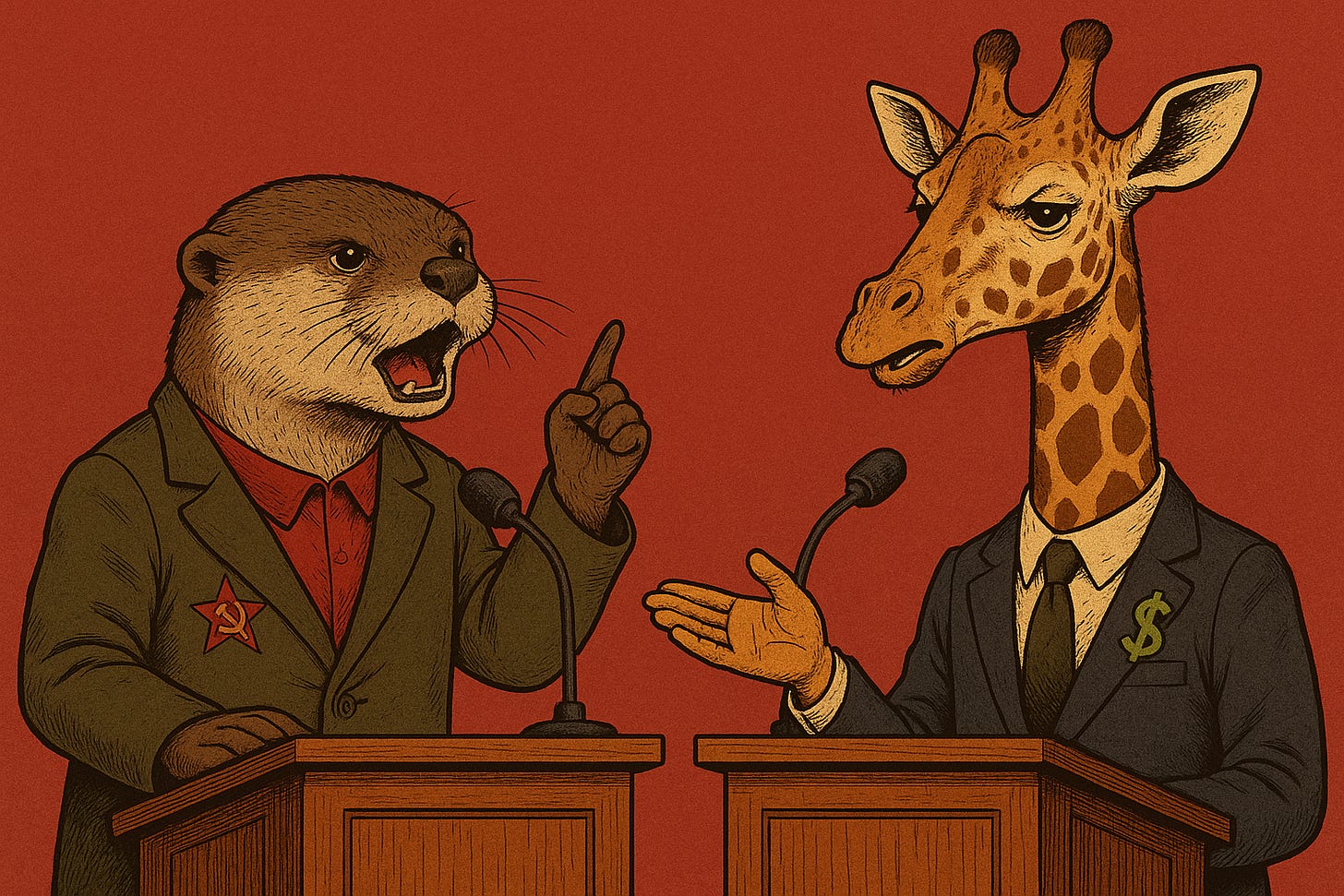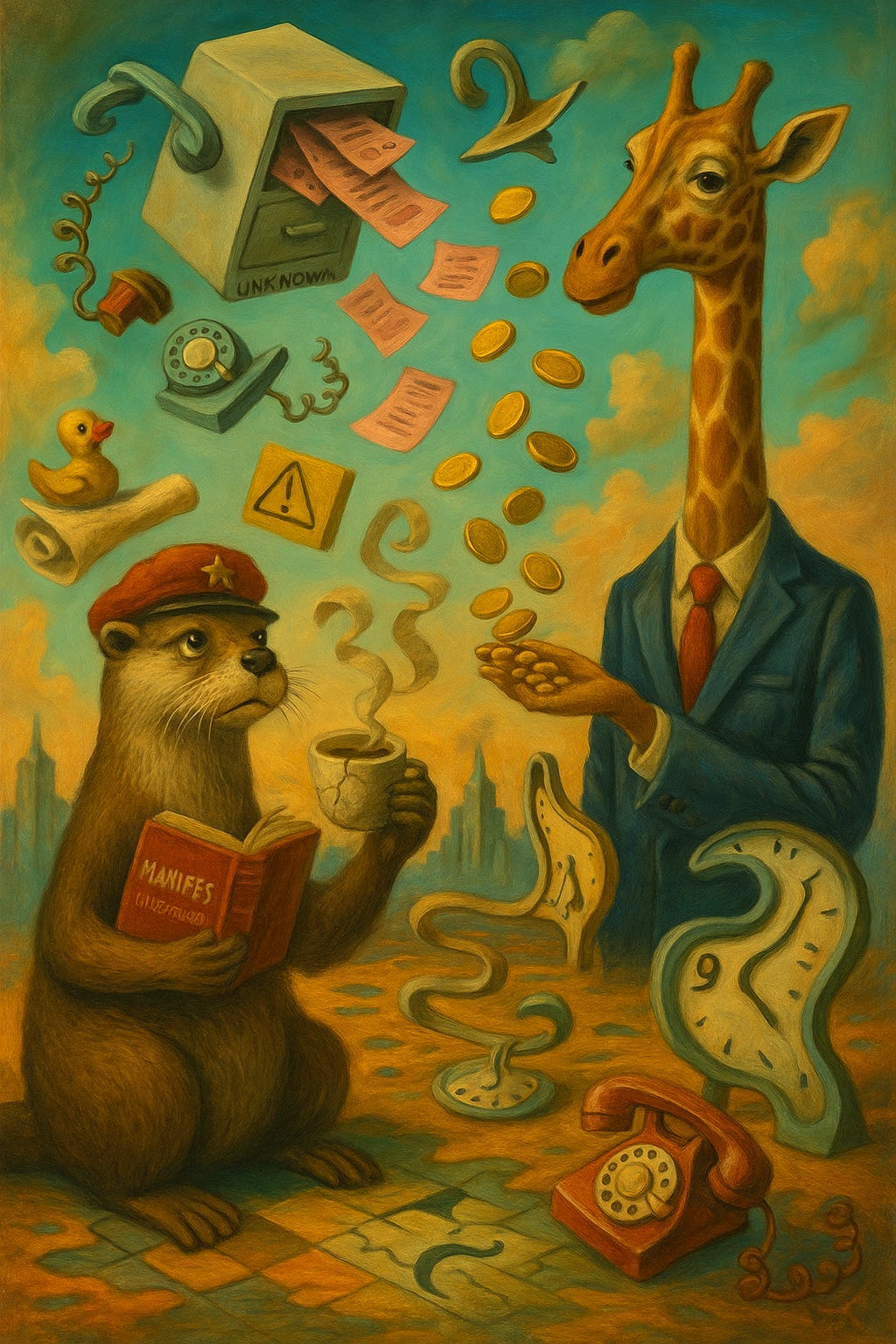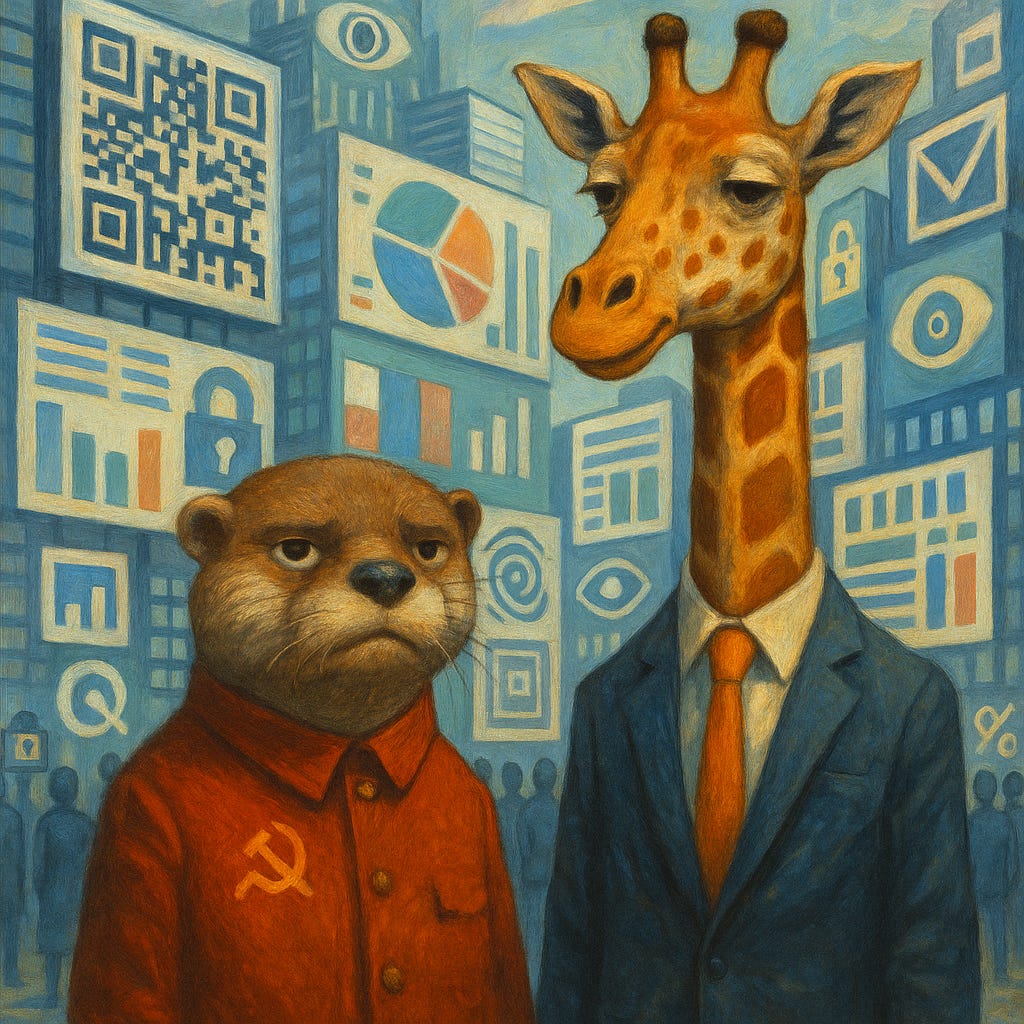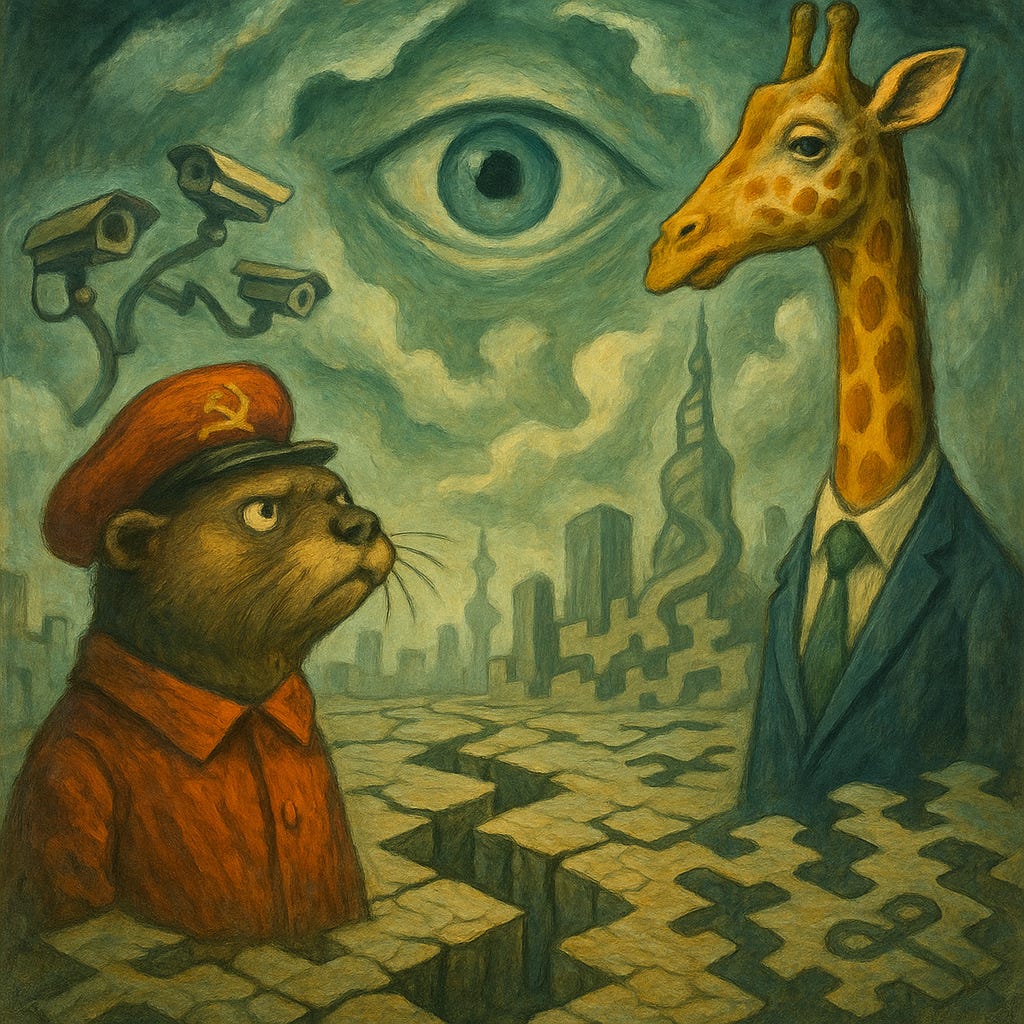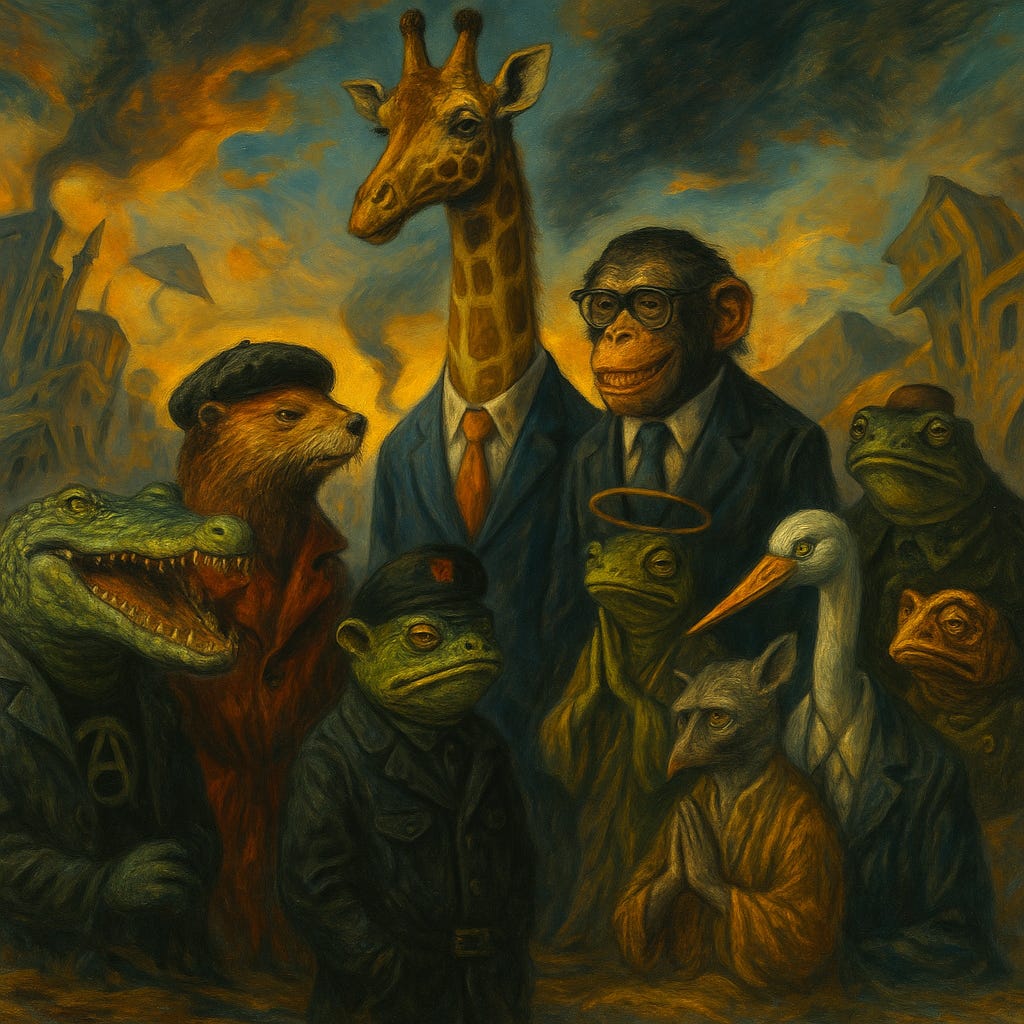Part 1: Introduction
We were never supposed to understand the system. That was never the assignment. We were supposed to trust it—unquestioningly, like a child nodding at bedtime stories.
Trust the dollar. Trust the news. Trust the science (but only the right kind). Trust the process (as long as you don’t ask what the process is). Trust the Federal Reserve—this unelected conclave of monetary magicians. Trust the wars, especially when they’re far away and wrapped in flags and euphemisms like “stability” and “strategic interest.” And when the entire thing malfunctions, panics, and cannibalizes itself in front of you, the answer is always the same: Oops. A miscalculation. A rare event. An unforeseeable “black swan.” But here’s a treasonous thought: What if the collapse isn’t a bug? What if it’s a feature? What if the crash isn’t the end—but the beginning? Not a reset, but a rewrite. A New World Order—not the shadowy fantasy from internet forums. But a beginning we must see through to its end, which itself becomes another beginning. And on and on she goes.
This series starts from a deceptively simple premise: history is a catalog of human failure. Not because we’re stupid or lazy or hopelessly inefficient, but because the system—whatever name you give it: The Machine, The Matrix, The Grid, Delaware—is designed to fail, cyclically and profitably. What we’ve been taught to look for—truth, in its clean, capital-T form—was never there to begin with. Every solution becomes tomorrow’s problem. Every breakthrough becomes a trapdoor. And the system doesn’t guide—it misleads. It doesn’t clarify—it confuses. Its genius lies in convincing you there’s a solvable puzzle, when in fact the puzzle was built to be unsolvable. And the moment you start asking uncomfortable questions—about debt, death, central banks, media narratives, about why your life feels less like something you chose and more like something you inherited, misunderstood, and stumbled through—you get labeled. Conspiracy theorist. Nihilist. Pessimist. Or worse: unrealistic. But we know the playbook. Just wait a few years. The same polished politicians, parroting the war scripts of their corporate sponsors, will eventually step to a podium and declare—wide-eyed, shocked—that WE were right all along.
Rinse. Wash. Gaslight. Repeat.
But are we truly the unrealistic ones? In a world that builds smart fridges while millions starve, where children mine rare earth minerals so billionaire autists can launch the next “revolutionary” gadget? In a culture that gamifies grief and sells dopamine by monthly subscription? In an economy that requires endless war just to simulate peace? Unrealistic? No. Unrealism is the default. It's the operating system of modern life. And paradoxically, it’s also the very thing that keeps us evolving—failing forward, lurching toward meaning without ever quite landing on it. Let the record show: we asked. We poked the bear. We whispered the forbidden “why.” This series is our breadcrumb trail through the fog. It won’t give you answers—we don’t have them. But maybe, just maybe, it offers something better: permission to say, with radical honesty and cosmic humility:
We don’t know shit.
A World Built on Fiction
Every empire begins with a story it dares you not to believe.
Rome had its gods—petty, wrathful, fond of orgies and vengeance. Britain had its tea, powdered wigs, and a globe it mistook for a dartboard. And America—sold on the illusion of freedom—chose the Dream. And we believed it. We took the internships, signed the leases, opened the credit cards. We learned to network, small talk, nod. We called it adulthood. We called it success. But dreams—like teeth and treaties—rot when ignored. And rot smells. So the story had to evolve.
The Founding Fathers became action figures and sitcom dads. Freedom got a jingle. Liberty started doing photo ops in Vegas. If the Dream was alive—if it was sacred—why did the networks need to pump it out on the hour? Why repeat it until we stopped asking if it was ever real? The lie isn’t hidden anymore. It’s the system itself; presented as a means to an end but designed to self destruct. It’s embossed, branded, and available in four colors, two sizes, and a limited-edition NFT drop. And we are expected to clap anyway. We’re expected to rate our own delusion. We are, most of the time, participants in a simulation inside a simulation. And the worst part? The most horrifyingly banal part?
We clicked “agree.”
We didn’t just believe the fiction. We licensed it. And what does that make us? Co-authors. Extras. Laugh tracks. Consumers of our own captivity. History, it turns out, isn’t written by the victors. That’s far too noble, too textbook. No—history is ghostwritten by ad executives, curated by lobbyists, and test-marketed before it's told. It’s a retroactive branding exercise, wrapped in the illusion of inevitability. It’s not a record of progress. It’s a museum gift shop built before the exhibit. This world—the one they insist is solid, sensible, and spinning along just fine—isn’t built on truth. It’s built on a scaffolding of narrative convenience, reinforced with selective memory and institutional amnesia. It’s not that we’re not in Kansas anymore. It’s that Kansas never existed in the first place. But here’s the beautiful, revolutionary truth:
The moment you recognize the fiction, you can start imagining something real.
The Age of False Certainty
The 20th and early 21st centuries did something strange to the human brain. It made us allergic to ambiguity.
We were taught to worship the high priests of modernity—economists who turned chaos into PowerPoints, bankers who cast monetary spells, generals who outsourced morality to drones, and journalists who spoke in the sacred dialect of Objectivity™. These were the Insiders—credentialed, photogenic, and serenely detached. We swallowed the myth that if we just kept moving, kept producing, kept nodding along, we’d eventually arrive somewhere better. But we’ve been running on a treadmill facing a brick wall. This is a civilization built on assumptions rather than understanding. Progress is mostly repetition dressed up as something new. Truth has been replaced by popularity. Doubt is mistaken for incompetence, humility for weakness. We pretend to know what we're doing, and every time reality reminds us otherwise, we respond with disbelief instead of reflection.
But here’s the thing: it doesn’t matter. It never did.
Because the story never holds. Systems built on illusions require constant change. So it moves the goalposts, renames the variables, updates the UI. Not to deceive us—but to keep itself from collapsing under the weight of its own absurdity. When every institution contradicts itself, it’s not a mistake—it’s a way of numbing you into accepting that meaning is always provisional, that certainty is a luxury product you’ll never quite afford.
The world hums with practiced ease and showroom smiles. Explanations now arrive before the events. Everyone’s sure of everything—yet no one can explain why. This isn’t collapse as spectacle. No sirens. No sparks. Just a slow, clinical compression. A narrowing of imagination dressed up as common sense. We're told to “move forward,” but every door leads back to the same hallway. We’re told we’re “free,” but freedom now means choosing from a list someone else wrote. We’re told “everything is fine.” But the pit in our stomach says otherwise. This isn’t neglect. It’s maintenance. A world groomed to keep us adjacent to meaning but never inside it.
What The Heck Even is This?
Let me be clear!
This is not investment advice —unless you count investing in pattern recognition, strategic paranoia, and maybe a few cans of sardines. And it is certainly not financial education. Because to “educate” someone financially assumes there’s a stable curriculum, a coherent textbook, a system with rules. But you don’t live in a system. You live in a liquidity mirage disguised as an economy, where the rules change mid-sentence and the final exam has no answer key.
This is a wake-up call!
It's a literary time capsule addressed to whoever’s left after it all ends. This won’t tell you what to buy. It won’t tell you what’s coming next. Because the whole point is: no one knows. We’ve watched the Overton window whip like a weather vane in a hurricane. One day dissent is dialogue, the next it’s disinformation. None of this is normal. But normal was never the point. We are living through the earliest phases of a global restructuring—not of values, but of infrastructure. This is not the revolution of flags and manifestos. It’s Kafka in a Silicon Valley hoodie. It’s the same game—just played under different names. So what are we doing here? We are not here to be right. We are here because asking the wrong questions was always the only way out. We will trace the contours of the collapse—not to predict what comes next, but to see it clearly as it happens. To opt out with suspicion, courage, and humor. With the kind of skepticism that comes not from bitterness but from survival.
From Chaos to Clarity: The 10 Step Journey
In this series, we’ll explore a piece of the simulation that’s been passed off as “truth.”
Part 2: History Isn’t What Happened—It’s What Was Allowed to Survive
Textbooks aren’t records; they’re curation. Every empire retrofits its own origin myth, edits out the body count, and sells it as required reading. We'll show you how the past is managed like intellectual property—because it is.
Part 3: The Age of Performative Everything
Fake markets. Fake debates. Controlled opposition wearing branded hashtags. You’re not watching democracy—you’re watching WWE: Globalism vs. Nationalism in a never-ending grudge match, slamming each other through tables while winking behind the curtain.
Part 4: The Algorithm Wears a Suit Now
They called it “financial inclusion.” It’s actually programmable compliance. CBDCs, ESG scores, biometric governance—beneath the jargon is a logic of total control.
Part 5: It’s the Liquidity, Stupid
Capital creates gravity. We'll explain how XRP, XDC, and others aren't speculative assets, but infrastructure for a new global nervous system.
Part 6: What Breaks First
Every system has stress points—watch the ones they pretend don’t exist. We'll spotlight the institutions already hollowed out, where cracks are masked with PR campaigns and “mission statements.”
Part 7: The Great Reset You Weren’t Expecting
While everyone feared a communist takeover, the real shift was to a global technocracy. The revolution wasn’t televised. It was white-papered.
Part 8: Sovereign Stack vs. Slave Stack
Two futures are being coded. One gives you optionality. The other gives you nudges. We'll show you how to recognize the difference—and why most won’t.
Part 9: The Prebuilt Future
Collapse isn’t failure—it’s rollout. From cashless test labs in Nigeria to regulatory sandboxes in the EU, the blueprints for post-collapse governance are already running. And guess what? You’re in the beta test.
Part 10: The End Isn’t Near—It’s Always Been Here
Not with a bang, but with a log-out. When the systems fail to define us, we get to start again—not with certainty, but with sincerity. The future isn’t about control—it’s about remembering what it means to be human in a world that forgot.
You made it this far. So buckle up, traveler.
The descent begins.
A New Kind of New World Order
Once upon a time, the future was something you could fantasize about. It had jetpacks, moon colonies, and brunch on Mars. It was smooth and metallic, radiating post-war optimism and pre-packaged belief systems. The future used to feel like an upgrade.
Now? The future feels like a waiting room with flickering lights. The magazines are decades old. The receptionist’s gone home. We don’t know what we’re waiting for—only that something’s supposed to happen. Eventually. If this world is a riddle with no answer then maybe what we need isn’t a solution, but a new kind of orientation. Not a compass that points north—but one that warns us when something isn't adding up. One that steadies us when reality tries to slip out from under our feet. We need a framework that doesn’t short-circuit in contradiction. That isn’t addicted to linear narratives, but thrives in endless repetition and nested paradoxes
Because that’s the real question. Not who’s in charge. Not what the headlines say. But what happens when the system buckles? We’re not prophets. We’re not experts. We’re just people paying attention, walking the wreckage, trying to name what’s real. Mapping not the plan, but the pattern. The soft spots. The collapses that don’t make headlines but shape everything anyway. Because here’s what no one wants to admit: most people don’t want the truth. They want to feel okay. They want a fix. A forecast. A story that says the grown-ups are in charge.
You’ve felt it.
That this chaos isn’t random. That the cracks aren’t new—they were always there, hidden under decades of borrowed time. That the system didn’t fail. It functioned exactly as designed—just not for you. So let’s stop pretending. This “new normal” isn’t new. It’s just the same script updated with gentler fonts and friendlier passwords. And if it feels orderly, that’s only because disorder has been normalized. You don’t fix this by shouting. You don’t out-argue it. You stop looking for a hero. You become someone who sees what’s broken—and still chooses to care. History’s not just watching. It’s respawning. And this time, you’re not the observer.
You’re in it.
You Are Not Crazy (Okay Maybe a Little)
Let’s clarify something: paranoia, in this context, is just premature pattern recognition.
You’re not imagining the distortion—you’re immersed in it. The gaslighting isn’t some abstract psychological concept; it’s policy. It’s strategy. The world moves rhythmically—like a soundtrack to a collapsing consensus. And here we are, rubbing our eyes like some digital-age Diogenes asking, “Why does this all feel scripted?”
Let’s follow the threads:
Why are the IMF, BIS, and World Bank all onboarding blockchain developers like it's a new religion? Why are ancient institutions suddenly obsessed with distributed ledgers after decades of pretending they were a nerdy sideshow? Why are billionaires hoarding water rights, farmland, lithium, and low-orbit satellite constellations like they're assembling a real-life villain starter pack? Why is the Federal Reserve launching its own payment rail (FedNow), while pretending it’s not a precursor to a central bank digital currency? Why is every "open-source" AI breakthrough somehow funded by DARPA, Microsoft, Palantir, or a rotating cast of defense-affiliated venture capitalists?
You’re not crazy. You’re awake in a burning theater—while the crowd keeps clapping for an encore.
Because here’s the real punchline: the reset isn’t coming. It’s already here. The new system isn’t being announced to us on CNN. It’s being deployed right in front of our faces while being promised that its not. You’ve probably felt it in your gut for months. Years, even. This isn’t mental illness. It’s called being early. And yes, it’s lonely. Yes, it makes parties awkward. Yes, sometimes you start ranting about fourth-turning liquidity cycles to someone who just wanted to talk about the weather.
So no, you’re not crazy. You’re just one of the few who decided to stop dancing to a beat no one else hears anymore. The question now isn’t whether the world is changing. It’s whether you’re willing to change with it—before it changes you.
The Thesis Doesn’t Even Exist
What this series orbits is a set of three stubborn, slippery, uncomfortable beliefs.
1. Progress is a myth.
The system isn’t malfunctioning—it’s functioning exactly as designed. Every institution you were told to trust is held together by outdated incentives, terminal debt, and a story no one believes anymore. We aren’t headed toward utopia or dystopia—we’re circling a drain built by committees who mistook quarterly profits for meaning. The dream was always a trap.
2. Truth is a luxury item—and nobody’s buying.
There is no objective lens left—only filtered narratives, targeted ads, and statistical illusions. Reality has been partitioned, versioned, and licensed. Every new “solution” is a placeholder for the next crisis. Truth, if it ever existed, has become uneconomical to maintain. What survives is what performs, and what performs is whatever doesn’t threaten the storyline.
3. You don’t need the answer. You just need to stay curious enough to notice when things stop making sense.
The people who cling to certainty are the first to miss the shift. This world isn’t built to be figured out—it’s built to keep changing the rules. You don’t win by being right. You win by paying attention, questioning everything, and being ready to change your mind. That’s not weakness. That’s survival.
And that’s it.
That’s the radical thesis: we don’t know shit. But neither does anyone else. And in that shared disorientation, that glorious absence of certainty, is your edge. Because the ones who claim to know exactly what’s going on? They’re either lying or selling something. The rest of us are just trying to survive the day—dodging collapse, or worse, getting caught caring. But we refuse to be domesticated by consensus. Because somewhere deep down, we already know: this thing—whatever it is—has no coherent plot. So we start treating the world like what it really is: a collapsing improv act in a building with no exits. There is no correct path. So Stop looking for permission. Stop worshipping the nice folks on the TV. They were never designed to save you. They were designed to use you.
We must become our own infrastructure.
Because yes, we were lied to. Not once. Constantly. Systematically. Elegantly. By teachers. By politicians. By scientists in white coats and pundits in makeup and CEOs in fleece vests. And the moment we truly accept this—not just in theory, but in our bones—is the moment we begin to reclaim our future. This series isn’t about being right. It’s about remembering that no one is. That the only thing more dangerous than being wrong… is pretending not to be. So we don’t panic. We crave the chaos. Not because it’s comfortable—but because it’s honest.
We don’t need predictions. We need posture. And posture—the ability to stay upright in a world tilting sideways—is how we keep going.
Welcome to the Reality that isn’t Real
The world won’t end with a bang—but with a subtle, relentless rewrite of everything we thought was stable. Systems will stall. Interfaces will update. Definitions will shift. And they’ll call it coincidence, progress, or "just another technical issue."
But you’ll know better.
The essays ahead trace the edits: to history, to policy, to the stories behind our markets and the machines behind our meaning. You won’t leave with all the answers. But you will leave with better questions. Sharper instincts. And a deeper understanding of the world that’s being smuggled in beneath your feet.
So no, the reset won’t be televised. But it will be documented.
Right here.




